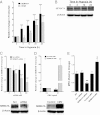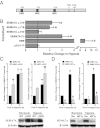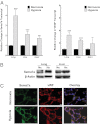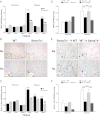Endothelial Semaphorin 7A promotes neutrophil migration during hypoxia
- PMID: 22891341
- PMCID: PMC3435204
- DOI: 10.1073/pnas.1202165109
Endothelial Semaphorin 7A promotes neutrophil migration during hypoxia
Abstract
Recent studies identified basic biological principles that are shared by the immune and the nervous system. One of these analogies applies to the orchestration of cellular migration where guidance proteins that serve as a stop signal for axonal migration can also serve as a stop signal for the migration of immune-competent cells. The control of leukocyte migration is of key interest during conditions associated with inflammatory tissue changes such as tissue hypoxia or hypoxic inflammation. Semaphorins are members of these axon guidance molecules. Previously unknown, we report here the expression and induction of semaphorin 7A (SEMA7A) on endothelium through hypoxia-inducible factor 1α during hypoxia. This induction of SEMA7A translates into increased transmigration of polymorphonuclear neutrophil granulocytes across endothelial cells. Extension of these findings demonstrated an attenuated extravasation of polymorphonuclear neutrophil granulocytes in Sema7a-deficient mice from the vasculature during hypoxia. Studies using chimeric animals identified the expression of Sema7A on nonhematopoietic tissue to be the underlying cause of the observed results. Taken together, our findings demonstrate that neuronal guidance proteins do not only serve as a stop signal for leukocyte migration but also can propagate the extravasation of leukocytes from the vascular space. Future anti-inflammatory strategies might be based on this finding.
Conflict of interest statement
The authors declare no conflict of interest.
Figures




Similar articles
-
Semaphorin 7A Aggravates Pulmonary Inflammation during Lung Injury.PLoS One. 2016 Jan 11;11(1):e0146930. doi: 10.1371/journal.pone.0146930. eCollection 2016. PLoS One. 2016. PMID: 26752048 Free PMC article.
-
Endothelial Semaphorin 7A promotes inflammation in seawater aspiration-induced acute lung injury.Int J Mol Sci. 2014 Oct 28;15(11):19650-61. doi: 10.3390/ijms151119650. Int J Mol Sci. 2014. PMID: 25353180 Free PMC article.
-
Red blood cell-derived semaphorin 7A promotes thrombo-inflammation in myocardial ischemia-reperfusion injury through platelet GPIb.Nat Commun. 2020 Mar 11;11(1):1315. doi: 10.1038/s41467-020-14958-x. Nat Commun. 2020. PMID: 32161256 Free PMC article.
-
The involvement of semaphorin 7A in tumorigenic and immunoinflammatory regulation.J Cell Physiol. 2021 Sep;236(9):6235-6248. doi: 10.1002/jcp.30340. Epub 2021 Feb 21. J Cell Physiol. 2021. PMID: 33611799 Review.
-
Semaphorin7A and its receptors: pleiotropic regulators of immune cell function, bone homeostasis, and neural development.Semin Cell Dev Biol. 2013 Mar;24(3):129-38. doi: 10.1016/j.semcdb.2013.01.002. Epub 2013 Jan 16. Semin Cell Dev Biol. 2013. PMID: 23333497 Review.
Cited by
-
Attenuating effect of Ginsenoside Rb1 on LPS-induced lung injury in rats.J Inflamm (Lond). 2014 Dec 5;11(1):40. doi: 10.1186/s12950-014-0040-5. eCollection 2014. J Inflamm (Lond). 2014. Retraction in: J Inflamm (Lond). 2023 Nov 29;20(1):42. doi: 10.1186/s12950-023-00368-5. PMID: 25530718 Free PMC article. Retracted.
-
Neutrophil Recruitment: From Model Systems to Tissue-Specific Patterns.Trends Immunol. 2019 Jul;40(7):613-634. doi: 10.1016/j.it.2019.04.010. Epub 2019 Jun 4. Trends Immunol. 2019. PMID: 31175062 Free PMC article. Review.
-
Neuronal guidance proteins in cardiovascular inflammation.Basic Res Cardiol. 2021 Jan 29;116(1):6. doi: 10.1007/s00395-021-00847-x. Basic Res Cardiol. 2021. PMID: 33511463 Free PMC article. Review.
-
Semaphorins and Their Receptors: From Axonal Guidance to Atherosclerosis.Front Physiol. 2018 Oct 12;9:1236. doi: 10.3389/fphys.2018.01236. eCollection 2018. Front Physiol. 2018. PMID: 30405423 Free PMC article. Review.
-
Association of Immune Semaphorins with COVID-19 Severity and Outcomes.Biomedicines. 2023 Oct 13;11(10):2786. doi: 10.3390/biomedicines11102786. Biomedicines. 2023. PMID: 37893159 Free PMC article.
References
-
- Rosenberger P, et al. Hypoxia-inducible factor-dependent induction of netrin-1 dampens inflammation caused by hypoxia. Nat Immunol. 2009;10:195–202. - PubMed
MeSH terms
Substances
LinkOut - more resources
Full Text Sources
Other Literature Sources
Molecular Biology Databases

